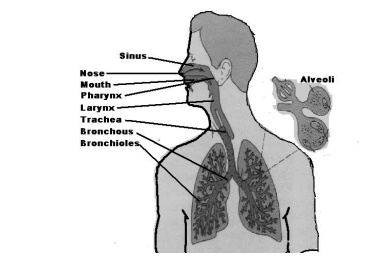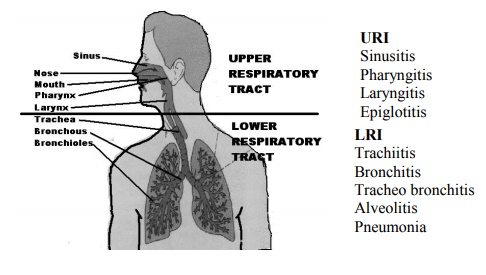Chapter: Microbiology
Respiratory tract infections
RESPIRATORY TRACT INFECTIONS
Introduction
The lower respiratory tract is sterile. However the upper respiratory tract, the nose and throat are colonized by many organisms.
Normal flora of respiratory tract
These organism are: Staphylococci, Streptococci, Pneumococci, Haemophilus and Neisseria.

Normal defenses against infections
1. Arrangement of nose – there is no direct entry of air
2. Broncho constriction : helps the organisms to be trapped
3. Cough reflex : expels the microbes out side
4. Mucociliary blanket: traps the organisms
5. Mucosal factors: kill the organisms a. Non specific
i. Lysozyme : Cell wall of gram positive organism are lysed
ii. Influenza virus inhibitors :
iii. Resident macrophages : kill the organism
b. Specific
i. Secretory IgA antibody : gives first line of defense
Predisposing factors for respiratory tract infections
1. Ciliated epithelial cell damage due to
a. Viruses
b. Chemicals
c. Smoking
2. Fluid accumulation
3. Decreased activity of macrophages
All these factors help in the establishment of the microbes in the respiratory tract.
Alveoli
Strep.pneumoniae ; M.tuberculosis ; Mycoplasma pneumoniae
Chlamydia pneumoiae
Types of Respiratory infections (Figure 15.3)
Respiratory infections can be conveniently classified into Upper respiratory and Lower respiratory infections.

Upper respiratory tract infections (URI)
1. Infections of the paranasal sinuses
URI may cause inflammation of the maxillary sinuses. Bacterial infection also occurs in association with obstruction. The bacteria involved areStreptococcus pneumoniae,Haemophilus influenzae, Staphylococcus aureus, Streptococcus pyogenes.
2.Otitis media
This is the result of direct spread of pathogens from the throat via the Eustachian tube. In young it may be due to Streptococcuspneumoniae, Haemophilus influenzae, Streptococcus pyogenes. Inold people it may be due to Streptococcus pneumoniae, Staphylo-coccus aureus.
3. Sore Throat
It occurs in the following conditions:
1. Prodromal stages of infectious diseases
2. Diphtheria
3. Vincent’s infections
4. Sore throat syndrome
Prodromal stages of infectious diseases
Many viral diseases are acquired via the respiratory tract. Signs and symptoms appear in the mouth and throat. But the target organs may be different.
Example: In measles and chickenpox, the mucosae of the upper respiratory tract and mouth are infected before the target organs show full clinical picture. In measles Koplick’s spots appear in buccal mu-cosa.
Diphtheria
Diphtheria is an acute inflammatory condition of the upper respi-ratory tract usually the throat. It is caused by Corynebacterium diphtheriae. The organisms multiply in the throat and produce a pow-erful toxin. The toxin acts on myocardium, adrenal glands and nerve endings.
Laboratory diagnosis
Throat swab is collected
1. Smear is stained by Gram and Albert stains
a. In positive cases Gram positive bacilli seen
b. Albert stain shows bacilli with metachromatic granules2. Material is inoculated into Blood agar, Loeffler’s se-rum medium and Potassium tellurite agars
3. Suspected colonies are identified by biochemical test using se-rum sugars
4. Toxigenicity test is done by agar gel precipitation test (Elek’s test) and by guinea pig inoculation test
Prophylaxis
l Active immunization is done
l DPT (Diphtheria, Pertusis and Tetanus) immunization should be given in three doses
l 1st dose at third month
l 2nd dose at 6-8 weeks after the first dose
l 3rd dose 4-5 months after the 2 dose
l A booster is given omitting the pertusis at school entry
Treatment
Large dose of anti toxin must be given to confirmed cases. Anti-biotics are given to eradicate the organisms .
Vincent’s infection
Vincent’s spirochetes are Borreliae
They are present as normal flora of the mouth
In association with fusiform bacteria they can cause infection Generally infection occurs during malnutrition
The infection is called Vincent’s angina
Sore Throat syndrome
Sour throat syndrome is caused by Streptococcus pyogenes. Based on the cell wall polysaccharide of beta hemolytic Streptococci they are put in different groups. Streptococcus pyogenes belongs to Group A. It causes wide range of pyogenic infections in the respiratory tract and skin and life threatening soft tissue infections. Post strepto-coccal infections may result in adverse immunological reactions leading to rheumatic heart disease or acute glomerulonephritis.
Laboratory diagnosis
For the laboratory diagnosis specimens like throat swab and pus are collected and inoculated in blood agar. The organism is identified by hemolytic property, and serological tests.
Penicillin is the drug of choice for the treatment of streptococcal infections.
Lower respiratory tract infections
Many organisms cause lower respiratory tract infections which you will be studying in later classes.
Related Topics